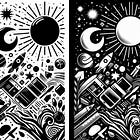What Tutorials Can Tell Us About Stylized 3D
MipMap #017: One Small Step for Stylization, One Big Leap for This Artist
In the pursuit of learning a new skill or technique, the tutorial is paramount. With the advent of platforms like YouTube, learning became so easily accessible that anyone could sit down and access information on any topic.
I distinctly remember sitting down with a student version (rest in peace) of Autodesk Maya 2017 and going through a very rough tutorial on creating a storage room on a spaceship. There wasn’t a single thing that I ended up actually learning from it, but the fact that I could sit down for an hour straight and pretend like I followed along with some type of learning was amazing.
The years since have made me realize that tutorials are both a blessing and a curse. On the one hand, you can access almost anything if you know where to look. On the other hand, anyone can make up anything.
However, we’re going to look at a series of interviews that fall squarely in the first category. These interviews were conducted with three different 3D artists and all pertain to creating an environment in a painterly style.
If you’ll recall the article from two weeks ago, I’m currently exploring Project TITAN, a community art challenge hosted by Epic Games. The goal is to create a world that will be used as a template for future Unreal Engine developers to play around in. It also utilizes a stylized look, one that I don’t have any experience with currently.
The above article detailed my broad analysis of what “stylized” art actually is. This time we’re going one step further, analyzing several of the guides that the Project TITAN team have referenced to understand what style of art is being made. In no particular order, they are:
Special shoutout to 80lv for hosting these articles, they are definitely worth a read for more insight than I can hope to provide here.
But without further ado, here are three principles I found while analyzing these interviews.
Composition Creates Control
It might seem obvious, but planning helps a lot.
To get the initial assumptions out of the way, all three artists utilized a single piece of reference as their guiding work, all three collected reference that showcased the mood and atmosphere they wanted to convey, and all three outlined the structure of the scene they wanted to showcase in some way.
Where it gets interesting though, is how they came to structure their compositions.
Lang Ma didn’t even begin to construct or blockout his scene until he had his foliage assets constructed.
Jasmin Habezai-Fekri fell into the composition of the scene after experimenting with the look of the landscape.
Ksenia Rezepova is the only one that used a traditional approach of determining the focal point of the scene and constructing the environment around it.
The point in all of this is that while all three artists were striving to create a piece of “stylized” art, they each had different goals they wanted to achieve. Those goals directed the way the scene evolved over time, whether it was purely composition, or highlighting certain assets, or just experimenting to see what looked best.
So when we’re looking at constructing our own scenes, or even just our own props and objects in general, we need to keep in mind what we want to focus on, and how do we go about constructing our scene to emphasize those points.
Everything is “Softer”
Again, this might draw groans from the “obviously” crowd, but hear me out.
I think an important distinction when it comes to “stylized” art is that things aren’t as pointed as they have to be in a realistic style. Like I had mentioned in my article from two weeks ago, realism is confined by logic and the forms that are tangibly possible. Stylized art doesn’t have that restriction.
A lot of that has to do with what we can get away with “implying” an object has.
If we look towards Jasmin Habezai-Fekri’s artwork, we can see that the large rocks in the background have cracks and crevices running throughout them. Except, they actually don’t, and are just details accentuated by the normal map. While normal mapping detail isn’t restricted to a stylized art style, you are able to get away with a lot more than you could with realism.
Look at the same rocks. Notice how the moss and foliage appears to grow over and looks quite complex. It’s actually not. Instead, it has been painted on using Unreal Engine’s foliage brush and uses some material manipulation in order to blend between rock and moss. The darker spots are actually the grass material that’s been slightly darkened in order to give the illusion of depth.
Finally, look at the grass and foliage in any of the artworks. It’s not obvious, but everything has had their normals manipulated. The way light interacts with the object has been intentionally changed to give the impression that these objects are complex plant life, when in reality they’re just 2D faces that reflect light in a unique way.
Now, that’s not to say that all of these techniques aren’t used in a realistic art style. Whether it’s 2D cards for foliage or faking depth through normal and texture manipulation, realistic art utilizes it all as well.
It’s simply that the bar for “getting away” with it is much, much higher with realism since we can look at it and know that that’s not quite how it should look in the real world.
That is what I mean by “softer.”
Don’t Overthink What Isn’t There
I had to take a second to come up with a catchy name for this section.
See, a problem that I (and maybe some others) experience when it comes to filling out a scene is that I don’t know what exactly I need to put in it.
Like sure, I know that I probably want a subject to focus on, and then slowly I want to build out supporting elements that should all tie together. That’s easier said than done though.
What I noticed in these three articles is that these artists don’t appear to have that problem. In fact, most articles and videos I read or watch normally give the advice to just fill out the scene with what makes sense, or find an asset pack to fill in the gaps with.
To be completely honest, the advice is solid. They just need to expand it a little bit more.
Obviously, using an asset pack solves the issue outright, but it almost feels too easy. Something, something, I’m too headstrong and/or broke to buy other people’s assets. But what about making my own assets?
As it turns out, the key lies in reusing assets that you already have, and making new assets that can be modified to appear as if they’re completely new.
Reusing assets is a tale as old as time, simply find a good way to categorize your assets and most DCCs allow you to just drag and drop them into your current scene. Touch up the materials, shift the colours and normals a bit, and voila. Almost an entirely new asset in a fraction of the time. It’s that second part that warrants further exploration.
Making your assets able to be modified in the moment is the part that’s conceptually challenging, especially when you don’t know how to exactly do that. It’s almost like when you realize that letters are just as valid in math. Hard to grasp, easy to grasp if you just overlook how everything actually works.
In the case of our articles, Unreal Engine provides a lot of tools that help our assets out. Vertex painting, virtual textures, decals, masks, shader nodes, etc. All of these have the ability to manipulate an existing asset by changing some aspect visually. And that’s only what is touched upon in the articles directly.
To summarize, don’t fret over thinking that you have to make dozens upon dozens of variations for each asset to make a scene feel unique. All you have to do is investigate what tools you can use to simulate that for you.
Outro
Who would have thought that so much could be learned by cross-referencing several tutorials on the same subject? I think part of the reasons why people get stuck in “tutorial hell” is because they take each tutorial at face value without realizing what is actually being taught. This was definitely me, I couldn’t internalize anything unless I repeatedly reviewed and asked for help. Cross-referencing and comparing/contrasting several sources is one way to go about it though. I would highly recommend it!
Until next week, stay stylized!
- Adam




